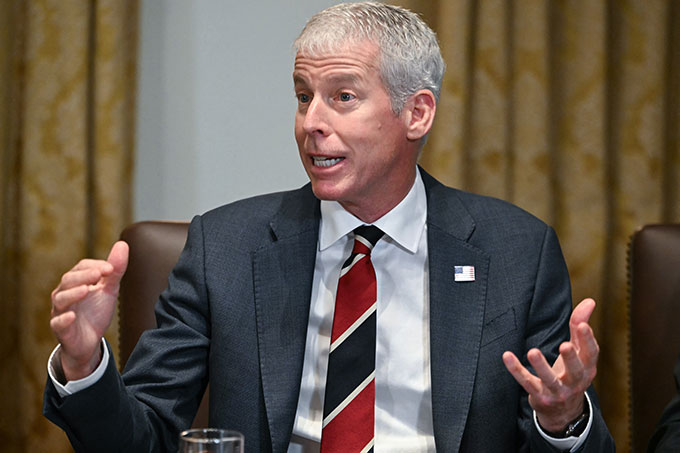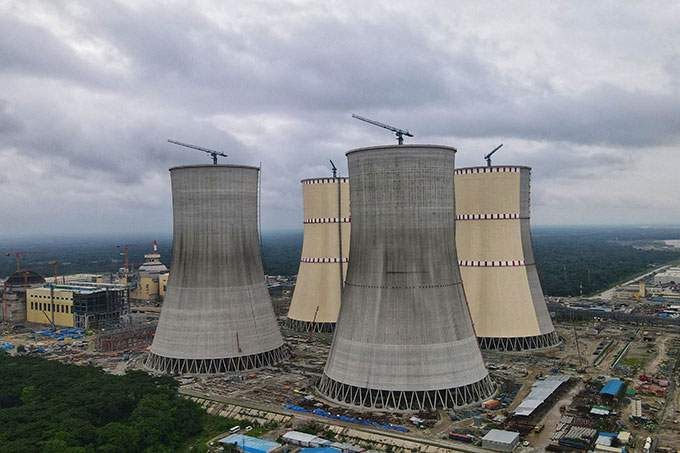For the first time in decades, the United States is taking serious steps to rebuild its nuclear energy capacity. Recent executive orders from the Trump administration outline an ambitious agenda, including reviving the domestic nuclear supply chain, modernizing the Nuclear Regulatory Commission (NRC), and expanding America’s role in global nuclear exports.
If the administration intends to compete internationally and meet America’s domestic energy goals, though, it needs to go further. It must address the neglect, regulation-induced delays, and declining expertise that have crippled the nation’s nuclear industry.
Finally, a reason to check your email.
Sign up for our free newsletter today.
The industry’s problems are myriad. Consider those highlighted in President Trump’s executive order “Reinvigorating the Nuclear Industrial Base.”
Start with the workforce crisis. The number of nuclear-engineering graduates dropped by more than 25 percent between 2012 and 2022, with only 454 bachelor’s degrees awarded in 2022. About 17 percent of the current workforce is 55 and older, with insufficient young professionals entering the field. The industry lacks qualified instructors, trainers, and educational programs. Without a careful strategy to address these factors, long-term growth of the industry will stall, even as new demand emerges.
The executive order prioritizes funding and investments to expand nuclear energy education, including grant support for nuclear energy-related programs and increased access to the expertise at National Laboratories for college and university nuclear engineering programs. While these are steps in the right direction, it will take significant time to build the workforce to the level required to achieve the administration’s goal of quadrupling current nuclear energy capacity by 2050.
Another key issue: spent-fuel storage. The nuclear industry’s inability to store waste indefinitely at reactor sites, partially driven by Congress’s failure to complete the Yucca Mountain waste-storage project, is a major liability. Washington has already paid billions in damages to utility companies for failing to meet its waste-disposal obligations, with costs growing each year.
Here, Secretary of Energy Chris Wright should establish an independent siting authority like Canada’s Nuclear Waste Management Organization, which has helped secure local consent for the construction of a permanent geological repository. Until the U.S. builds public trust in its waste-management strategy, the nuclear supply chain will remain fractured.

On the fuel-supply side, the president has instructed Wright to develop a plan to expand domestic production of low-enriched uranium and high-assay low-enriched uranium (HALEU), both of which are required for current and next-generation reactors, respectively. But private investment won’t grow without guaranteed demand. While producers have met the Department of Energy’s 900 kg HALEU production target, demand remains relatively limited, and a robust supply chain has yet to emerge.
Washington should enable the industry to build out a much larger and more coordinated fuel-supply chain to unlock meaningful private investment. One strategy is for the federal government to become one of the first buyers of nuclear fuel, creating guaranteed demand that enables enrichment providers to scale production and reduces risk for developers.
America’s nuclear industry also lacks the needed expertise to scale up production in reprocessing—the practice that separates viable nuclear materials from spent fuel for recycled use. Partnering with allies like Japan and France through initiatives such as the Sapporo 5—a five-country alliance to create a nuclear energy supply chain free of Russian dependence—could accelerate industry learning.
But even then, reprocessing facilities must be licensed by the sclerotic NRC, where licensing delays and a deeply risk-averse culture have become a bottleneck for innovation. That problem is targeted by Trump’s executive order, “Ordering the Reform of the Nuclear Regulatory Commission.” The NRC’s ultra-cautious posture, greatly shaped by heavy scrutiny after the 1979 Three Mile Island accident, has made inaction the norm. Only two new reactors have been deployed in the U.S. over the past two decades, while China has added more than 34 gigawatts of nuclear capacity in just ten years.
Over time, the NRC’s workforce has grown more single-minded, reinforcing the culture of obscurity that makes licensing harder to navigate. Some staff even avoid clarifying agency guidelines for fear of acting as a “consultant,” further raising the barriers for developers. In response, the administration proposes shifting licensing authority to agencies like the Department of Energy. But this risks increasing complexity, as these agencies lack experience regulating commercial civilian nuclear deployment. The executive order directs the NRC to reduce its staff as part of a broader reorganization effort, though it acknowledges that the commission may need to expand capacity to handle advanced reactor licensing.
Debate continues over whether the proposed reforms constitute necessary action or overreach. While concerns about preserving the NRC’s legitimacy are valid, the agency has strayed from its core mission: ensuring safety while enabling nuclear energy development. Reform should focus on delivering what experts have long demanded—clearer licensing pathways, firm timelines, and a fair chance for developers. Helping the NRC achieve these goals is a critical step toward rebuilding U.S. nuclear capacity and reestablishing global competitiveness.
Fixing the NRC is all the more important because of the need to compete with our adversaries, who have had a decades-long head start. The executive order “Deploying Advanced Nuclear Reactor Technologies for National Security” reflects this urgency, calling on the Secretary of State to “aggressively pursue at least 20 new 123 Agreements”—frameworks enabling U.S. nuclear cooperation abroad. Meantime, China and Russia have already mastered nuclear diplomacy, offering developing nations comprehensive “turnkey” packages that bundle financing, construction, fuel supply, and workforce training.
Agencies like the U.S. International Development Finance Corporation and Export-Import Bank (EXIM) are constrained by higher risk thresholds, longer approval cycles, and statutory limitations. The DFC—despite lifting its ban on nuclear finance in 2020—has yet to fund a single nuclear project and must notify Congress for agreements exceeding $10 million. EXIM is legally required to freeze new lending if more than 2 percent of its loan portfolio falls into default, making it highly risk-averse.
By contrast, both the China National Nuclear Corporation and Russia’s Rosatom routinely finance as much as 85 percent of total project costs. China, for instance, offers interest rates as low as 1.4 percent, compared with the 4.6 percent–4.8 percent floor typical of U.S. EXIM loans. EXIM typically caps repayment terms at 18 years (extended to 22 years for climate-change mitigation technologies); Rosatom’s financing of Bangladesh’s Rooppur Nuclear Power Plant includes a 28-year repayment term with a ten-year grace period.

Unless U.S. agencies coordinate and update their financing models, they will continue losing ground in emerging markets eager for energy security and economic growth. As the World Bank’s largest shareholder, the U.S. is well-positioned to shape nuclear funding access for developing nations and promote its own technologies in the process. By helping the bank build nuclear advisory capacity and offer competitive financing, the U.S. can create a stronger ecosystem for exporting American nuclear technology. With the World Bank’s decision to back nuclear energy, a critical new market has opened—and with it, an opportunity to reassert global leadership.
Trump’s recent executive orders represent a long-awaited step forward for nuclear power, but this is only the beginning. The government must not only revitalize virtually every link in the nuclear supply chain but also do so as electricity consumption grows.
That’s a tall task, and to accomplish it, America will need the support of allied nations. U.S. leadership abroad will depend on whether its financing ability can match the speed, scale, and cohesion of its Chinese and Russian counterparts. To lead in the new nuclear age, the U.S. must adopt the institutional changes this goal requires.
Top Photo: The shuttered Three Mile Island nuclear power plant in Pennsylvania (Chip Somodevilla/Getty Images)
Source link
















